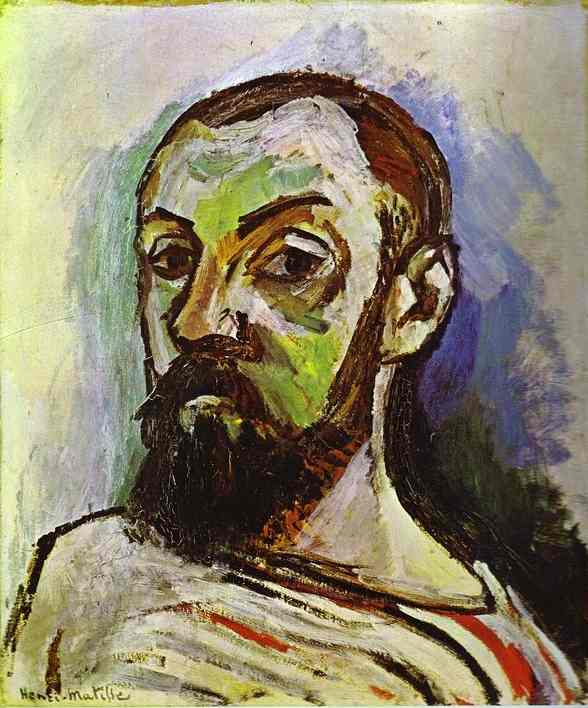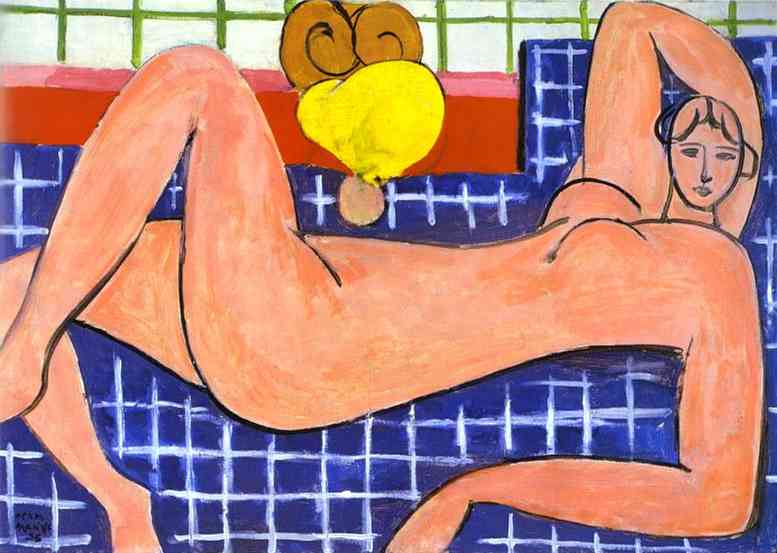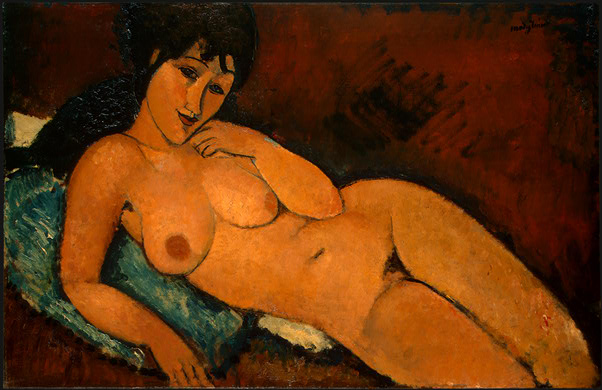|

|
| Matisse - Self-Portrait in a Striped T-Shirt (1906) |
Henri Matisse’s Pink Nude and Amedeo Modigliani’s Nude on a Blue Cushion are remarkably similar
works. Matisse and Modigliani were contemporaries for a portion of their lives during the early part of the 20th century.
It is clearly obvious that both artists were influenced by the various aspects of primitivism and the works of Cezanne. The
apparent content of each painting is that of a nude, laying down on a sofa or chair. The women drawn by both artists played
a role in their lives. The positioning of the bodies however is not unique but the painting as a whole is a new take on an
old idea. Although the works of these two artists are very similar, their lives and backgrounds are entirely different.
Both Matisse and Modigliani were influenced by many of the same artists. Matisse was primarily influenced by the works of
Cezanne, Gauguin, Van Gogh, and Signac. Modigliani was primarily influenced by Boldini, Lautec, and Cezanne. Matisse was
influenced by early Japanese art and Modigliani was influenced by African and tribal art. The ornate and decorative lines
in Matisse’s paintings show that he was interested in the blend of colors to create designs that revamped the traditional
Asian artworks. Modigliani’s few sculptures are very obviously derived from influences of African artworks. Modigliani’s
work also appears to have derived influence from several of Matisse’s works in the style of painting used. The use
of strong contrasting colors and thick brush strokes seems to reference many of Matisse’s earlier works that were completed
in contemporary to Modigliani’s work. If many of Modigliani’s paintings, the faces of the figures and nudes portrayed
are simplified and similar to the works of primitive artists.

|
| Modigliani - Self-Portrait (1919) |
One primary difference between the artists was the lives that they led. Matisse was a successful painter, proclaimed leader
of one of the most influential European artistic movements, the Fauves, and had wealthy Cone Sisters to buy all of his works.
Modigliani was poor, no body wanted his works, and hooked on drugs. Matisse was extremely successful and has been admired
since his began painting. Modigliani was ill the vast majority of his life and only now, nearly 90 years later is he gaining
a little recognition for his works. Modigliani grew up watching all of his artist friends become successful, while success
never came to him. So he turned to drugs and alcohol, which didn’t help his deteriorating health at all. Modigliani
spent the majority of his life with tuberculosis, which eventually killed him.
To put the paintings in a timeline context, the Modigliani work was completed towards the end of world war one. This atrocity
of a war was probably referenced by the violently blood red background in the work, with the blue cushion being a reference
to the coming peace when the war ends. Matisse’s work was completed in 1935 just prior to the Second World War. His
work depicts a woman with a very stern or serious facial expression, perhaps referencing the oncoming war. Amedeo Modigliani
died when he was 36, having completed his Nude on a Blue Cushion (1917) just three years prior to his untimely death.
Matisse completed his Pink Nude (1935) lived another 19 years and completed many more pieces of art. Matisse grew
up in France near the epicenter of modern art, Paris, while Modigliani had to move there after growing up in Italy.

|
| Matisse - Pink Nude (1935) |
Matisse’s work is significantly brighter than Modigliani’s. Matisse’s work uses bright red, yellow, blue,
and peach tones to set a lively mood to the model in the work. The play between all the colors and shapes was crucial to
Matisse’s works, and like many of his masterpieces, Pink Nude does not disappoint. Every last detail, color,
shade, line, form, and structure in Matisse’s work are in perfect balance and harmony. The model’s shape and
proportions are not correct, yet for some reason seem to fit the work almost effortlessly. The model has an extremely small
head and large thighs, but the disproportion is barely noticeable because it is such an integral part of the work. Also interesting
about Matisse’s work is the yellow form behind the model in the center of the work. It appears to be a cushion or pillow,
or just another stylistic element specifically placed to increase the balance of the work. The outlined body of the nude
in the image is not a reference to fauvism, however many aspects of the rest of the painting do reference Matisse’s
fauvist ideals of using colors as the primary subject of the works, and letting colors shape the painting and not lines.
The model in Pink Nude is Lydia Delektorskaya, who later took care of him in the 1940s after he contracted cancer.
During the 1930s, however Lydia became Matisse’s muse and close friend, since this work was completed in 1935; Delektorskaya
is the best guess as to the model in this beautiful painting.

|
| Modigliani - Nude on a Blue Cushion (1917) |
Modigliani’s work is significantly more depressing to look at, significantly darker, with thicker heavier brush strokes.
The model is much closer to actual proportions than Matisse's, yet for some reason both look unreal to the same degree.
The use of the blue pillow symbolizes the coming peace in the world in 1917 as the First World War was coming to a close.
The red background represents the violent bloodshed that the war has brought upon the world. And the model that is separating
this two colors of war and peace is where perhaps Modigliani feels that is his place to provide a barrier as an artist to
keep war and peace in two separate parts of the world. The model in Modigliani’s piece appears a lot more comfortable,
and the heavy use of lines in the model helps to create her degree of separation between her and the aspects of the background.
Her face has a lot more expression to it than the model in the Matisse work. She seems happy, or playful even, perhaps she
is trying to seduce the viewer. He eyes are deep and dark, connoting a sense of mystery or hidden thoughts that Modigliani
may have at that time about the women in his life. The model in his work is Jeanne Hebuterne, who later becomes his future
wife. Earlier in his life his models consisted of the women he found while out on the town on drugs, however in 1917 he met
this woman who helped him to settle his life and begin producing quality works. They had a daughter in November 1918, and
Modigliani dies less than two years later.
In conclusion, both works are exceptional in their ability to draw in the audience, to make the audience see something that
is both concrete and abstract, in the fact that both are paintings of nudes laying down, but both have a slightly abstract
representation of reality. Had the artists met, a dialog about these two paintings would have undoubtedly ensued because they
are so similar in appearance alone. The most interesting aspect of similarity is the fact that both of these paintings were
done in later stages of life, later being a respective term, and that the models in both of these paintings were women who
later ended up taking care of these artists on their death beds. Furthermore, the differences in the lives of the two artists
becomes apparent in these works because in 1935 Matisse is already a successful well established painter, when the work is
completed and Modigliani is failing in health and poor when his work is completed. Matisse's life influenced his work in
the shear use of colors with brightness and liveliness. Modigliani's life influenced his work in the same use of colors,
but with darkness and depression.
|
|
WORKS CITED:
Foster, Hal, Rosalind Krauss, Yve-alain Bois, Benjamin Buchloh. (2004) Art Since 1900 - Modernism, Antimodernism, Postmoderism.
Volume 1: 1900-1940, Thames & Hudson Inc. New York, NY USA.
Neret, Gilles. (1999) Matisse. Benedikt Taschen Verlag GmbH. Hohenzollernring, Koln GER.
Parsons, Lee. (2005) Modigliani – an artist between worlds. Modigliani: Beyond the Myth, World Socialist Web Site.
Accessed at: http://www.wsws.org/articles/2005/jan2005/modi-j18.shtml
Pioch, Nicolas. (2002) Modigiliani, Amedeo. WebMuseum, Paris. Accessed at: http://www.ibiblio.org/wm/paint/auth/modigliani/
Henri Matisse, (2004). Famous People. Accessed at: http://www.famouspeople.co.uk/h/henrimatisse.html
Biography. (2007). Amedeo Modigliani. Accessed at: http://www.expo-modigliani.net/2.cfm
LINKS:
Google
UMBC Homepage
Online Matisse Gallery
Online Modigliani Gallery
Baltimore Museum of Art
National Gallery of Art
|